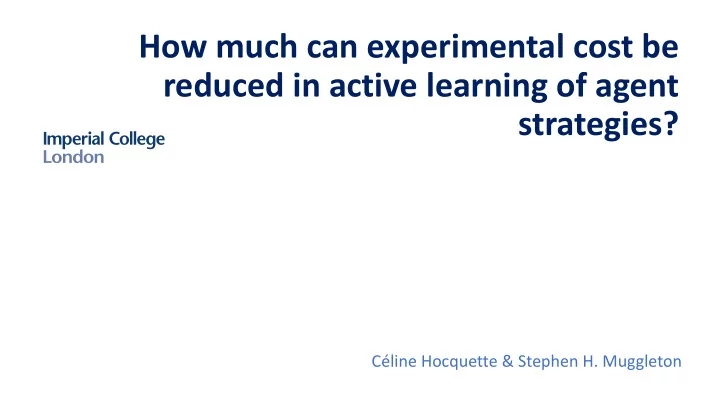

How much can experimental cost be reduced in active learning of agent strategies? Céline Hocquette & Stephen H. Muggleton
Learning agent strategies from observations ▪ Experimentation requires energy, time and resources ▪ Automated experimentation with active learning 2
Learning agent strategies from observations 3
Related work Size of the hypothesis Active Learning Target hypotheses learned space considered Robot Scientist (King et al, Finite (15) yes Abductive bindings 2004) MetaBayes (Muggleton et infinite no logic programs al, 2014) Efficiently Learning Efficient Reduced with Abstractions no strategies Programs (Cropper, 2017) Bayesian Active MIL (2018) infinite yes strategies 4
Related work ▪ Active Learning Widely studied for identifying classifiers • Other applications, among them Object Detection in Computer Vision • (Roy et al., 2016), Natural Language Processing (Thompson et al., 1999) ▪ Relational Reinforcement Learning 5
Framework ▪ Meta-Interpretive Learning ▪ Bayesian prior probability distribution over the hypothesis space ▪ Active Learning + - ent(e) = p log(p) + (1-p)log(1-p) 6
Framework 7
Implementation ▪ Regular Sampling (MetaBayes, 2014) ▪ Entropy of the instances measured from the sampled set of hypotheses 8
Theoretical Analysis What is the probability of selecting an instance ε -close to the entropy maximum? ▪ Active learner: selects the instance with maximum entropy among a set of N sampled instances Probability distribution P active (pi < p ε ) = (1- ε ) N P active (p ε ≤ p i ) = N ε - o( ε ) ▪ Passive learner: random selection P passive (p ε ≤ p i ) = ε ε 9
Results: Learning a Regular Grammar Entropy versus the number of Accuracy versus the number of Number of hypotheses versus the iterations iterations number of iterations q0([0|A],B) :- q1(A,B). q0([1|A],B) :- q0(A,B). q0([0|A],B) :- q0(A,B). q1([1|A],B) :- q1(A,B). 10 q0([],[]).
Results: Learning a Bee Strategy Accuracy versus the number of Entropy versus the number of Number of hypotheses versus the iterations iterations number of iterations f(A,B):- f2(A,C),grab(C,B). f2(A,B):- until(A,B,at_flower,f1). f1(A,B):- ifthenelse(A,B,waggle_east,move_right,move_left). 11
Conclusion ▪ Automated experimentation with active learning for learning efficient strategies while making efficient use of experimental materials ▪ Wide range of applications such as modelling butterfly behaviors 12
Future work: learning probabilistic models ▪ Generation of SLP by Super-Imposition ▪ Model scoring: sum of log posterior probabilities 𝑇𝑑𝑝𝑠𝑓 𝑁 = log(𝑄 𝑁 𝑓 ) = log 𝑄 𝑓 𝑁 + log 𝑄 𝑁 − log 𝑄 𝑓 𝑓 𝑗𝑜 𝑈𝑓𝑡𝑢 𝑇𝑓𝑢 𝑓 𝑗𝑜 𝑈𝑓𝑡𝑢 𝑇𝑓𝑢 13
Future work: multi-agents ▪ Learning a strategy for describing the behavior of an agent adapting in an evolving environment ▪ Applications: 2 player games 14
Thank you celine.hocquette16@imperial.ac.uk s.muggleton@imperial.ac.uk 15
References • A. Cropper. Efficiently learning efficient programs. PhD thesis, Imperial College London, 2017. • R.D. King, K.E. Whelan, F.M. Jones, P.K.G. Reiser, C.H. Bryant, S.H. Muggleton, D.B. Kell, and S.G. Oliver. Functional genomic hypothesis generation and experimentation by a robot scientist. Nature , 427:247-252, 2004. • S.H. Muggleton, D. Lin, J. Chen, and A. Tamaddoni-Nezhad. Metabayes: Bayesian meta-interpretative learning using higher-order stochastic refinement. In Gerson Zaverucha, Vitor Santos Costa, and Aline Marins Paes, editors, Proceedings of the 23rd International Conference on Inductive Logic Programming (ILP 2013) , pages 1-17, Berlin, 2014. Springer-Verlag. LNAI 8812. • Roy, S., Namboodiri, V.P.n Biswas, A., Active learning with version spaces for object detection, ArXiv e-prints, 2016 • Thompson, C. A., Califf, M. E., Mooney, R. J., Active Learning for Natural Language Parsing and Information Extraction, in Proceedings of the 16th International Conference on Machine Learning, ICML 1999, Morgan Kaufmann Publishers Inc. 16
Recommend
More recommend